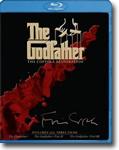 |
|
|||||||||||||||||||||||||||||||||||||||||||||||||||||||||||||
There are films that become so much a part of the collective consciousness that if a line is uttered it is recognized, even by those who have never seen it. The Godfather "I'm gonna make him an offer he can't refuse." The first film redefined the organized crime film at a time when it was mostly dead. Don Vito Corleone (Marlon Brando) is a man of honor and, strangely, the moral center of the first film. On the day of his daughter's wedding he is compelled, as a Sicilian, to grant any reasonable request. One such is to Bonasera, an undertaker whose daughter has been assaulted by some young punks. Bonasera didn't come immediately to Don Corleone, godfather to his only child, for help; he went instead to the police. Bonasera is gently reprimanded for this and for not being more friendly and sociable with his Don, who grants his request but leaves him with an unsettling caveat: "Someday, and that day may never come, I'll call upon you to do a service for me." The rules for conduct are established, but the era of this conduct is changing. Don Corleone is aging, and one of his sons will take over. Sonny (James Caan) is a hothead and an adulterer, likely to fly off the handle and therefore not good at diplomacy. Michael (Al Pacino) is just back from World War II, and he wants nothing to do with the family business. Fredo (John Cazale) is nice but not assertive - he doesn't command respect. When Don Corleone is injured, Michael takes control. You can see in Vito's eyes that he wanted better for his son, for this son. So much promise, lost on the family business. Michael takes the helm feeling a sense of duty and seeing what needs to be done. "I don't feel I have to wipe everybody out, Tom. Just my enemies." The Godfather Part II takes us down the road a few years. Michael has left New York and is living in Nevada. He has interest in several casinos and is looking to spread the business into Cuba. Things are tense, and we see Michael slipping. His wife, Kay (Diane Keaton), is tired of the family business and frustrated that Michael's promise to go legit hasn't borne fruit. She denies him an heir and leaves him, taking their two children. In a counter-story, we see a young Vito Corleone, this time played by Robert DeNiro, coming to power in New York after his parents are killed in Sicily. He overthrows the former neighborhood Don and works his way with his easy-going manner into a position of power. Bruno Kirby plays Peter Clemenza, who opens a door for Vito (and helps him steal a rug to repay a debt of gratitude). The scenes showing Vito coming to power are intercut with the scenes showing Michael's decline. "Just when I thought I was out... they pull me back in." The Godfather Part III jumps forward twenty more years to the late 1970s. Michael is finally making good on his promise to become legitimate. He makes a sizable donation to the church shortly after being bestowed a great honor. Michael is still approached by people from the old neighborhood and he tries to shrug them off, but he's been Don so long that it's a mantle not easily removed. Vincent Mancini (Andy Garcia) shows up at a party and is introduced as the bastard son of Michael's brother Sonny. Michael accepts him as family and tries to keep him on the straight and narrow. Eventually, he becomes a protector and muscle for Michael. He's as spirited as Sonny was, and he's fallen in love with Michael's daughter, Mary (Sofia Coppola). This doesn't sit well with Michael, and eventually Michael arranges to exchange control of the family for his daughter. Coppola has taken these films and made them more beautiful than ever before. I compared the film quality of the first film on Blu-ray with a copy I had from several years ago on DVD, cuing them up and playing them side-by-side. The improvement is remarkable. The obvious things like dust specks are removed, but the evenness in the lighting and colors is amazing in the remastered Blu-ray. The old DVD looks like a movie from 1972 transferred to digital. The colors are good, but you can almost see the celluloid moving past the lamp. Not so in the Coppola restoration. The only thing that gives it away as an older film is the youth of the actors. Along with the restored versions of the first two films (the third one from 1990 perhaps hadn't degraded enough to need any touch-up) and excellent, interesting commentary by Coppola on all three, there is a fabulous fourth disc filled with the wonders of behind-the-scenes comments from those who were there at the time and respected people from the film industry. Steven Spielberg admitts that he felt like quitting when he first saw The Godfather, it was so good. George Lucas adds his perspective as a filmmaker who was there at the time (and who actually shot some film for Coppola). Sarah Vowell contributes a touch (though not as much as I would have liked), as do the cast and creators of The Sopranos If you like cinema, if you like organized crime, if you like Pacino, Brando, or DeNiro, do yourself a favor; take the cannoli. Get The Godfather Collection - The Coppola Restoration |
|
|||||||||||||||||||||||||||||||||||||||||||||||||||||||||||||
|
||||||||||||||||||||||||||||||||||||||||||||||||||||||||||||||
| action | animation | art house/international | comedy | documentary | drama | family | horror/sci-fi | suspense | television | ||||||||||||||||||||||||||||||||||||||||||||||||||||||||||||||
| contact | home | ||||||||||||||||||||||||||||||||||||||||||||||||||||||||||||||



